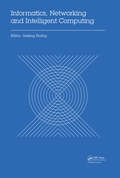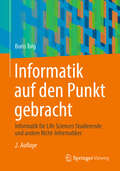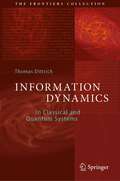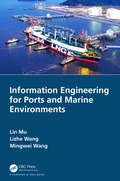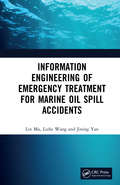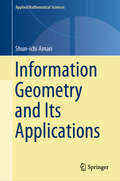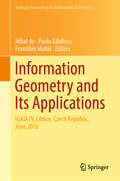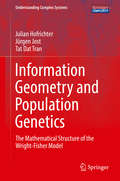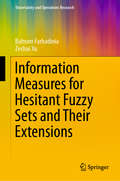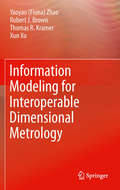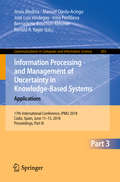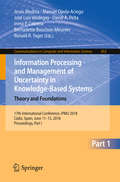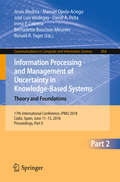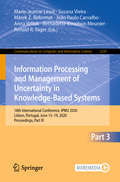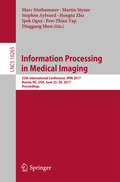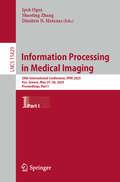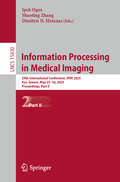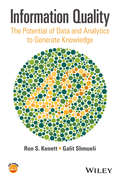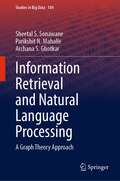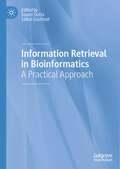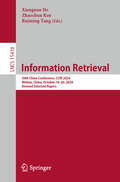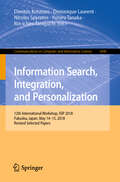- Table View
- List View
Informatics, Networking and Intelligent Computing: Proceedings of the 2014 International Conference on Informatics, Networking and Intelligent Computing (INIC 2014), 16-17 November 2014, Shenzhen, China
by Jiaxing ZhangThis proceedings volume contains selected papers presented at the 2014 International Conference on Informatics, Networking and Intelligent Computing, held in Shenzhen, China. Contributions cover the latest developments and advances in the field of Informatics, Networking and Intelligent Computing.
Informatik auf den Punkt gebracht: Informatik für Life Sciences Studierende und andere Nicht-Informatiker
by Boris TolgDieses Lehrbuch richtet sich an Studierende von fachfremden Studiengängen mit Informatikanteilen. Ein besonderer Schwerpunkt liegt dabei auf den sogenannten Lebenswissenschaften, wie Medizintechnik, Rettungsingenieurwesen, Biotechnologie, Umwelttechnik oder Verfahrenstechnik. Das Lehrbuch eignet sich für Leser in Studium und Praxis, die sich einen Einstieg in die Informatik verschaffen wollen. Die Besonderheit dieses Buches liegt in der problembasierten Herangehensweise, sowie der nach verschiedenen Taxonomiestufen konzipierten Übungsaufgaben.
Information Dynamics: In Classical and Quantum Systems (The Frontiers Collection)
by Thomas DittrichThis wide-ranging book introduces information as a key concept not only in physics, from quantum mechanics to thermodynamics, but also in the neighboring sciences and in the humanities. The central part analyzes dynamical processes as manifestations of information flows between microscopic and macroscopic scales and between systems and their environment. Quantum mechanics is interpreted as a reconstruction of mechanics based on fundamental limitations of information processing on the smallest scales. These become particularly manifest in quantum chaos and in quantum computing. Covering subjects such as causality, prediction, undecidability, chaos, and quantum randomness, the book also provides an information-theoretical view of predictability. More than 180 illustrations visualize the concepts and arguments. The book takes inspiration from the author's graduate-level topical lecture but is also well suited for undergraduate studies and is a valuable resource for researchers and professionals.
Information Engineering for Ports and Marine Environments
by Lizhe Wang Lin Mu Mingwei WangInformation Engineering for Port and Marine Environments provides the technology of tidal level prediction, the technology of oil spill early-warning, and the research for the theory of storm sedimentation, the construction for monitor ability, the early-warning service for numerical simulation and operational, which involves many aspects such as theoretical research, system establishment, and application of information technology, et al. Because of the certain prospective and advancement of multiple work, it will play a positive role in promoting the related technology of the field. There are several of important offshore ports in China, such as Tianjin port, Yangshan Port, Ningbo-Zhoushan port, Huanghua port et al., most of them are located in the coast of muddy and muddy silty, and the depth of water is shallow, the sediment deposition is serious, the large ship is operated by tide. In order to sufficiently keep the rapid and stable economic growth in bay, estuary and delta, guarantee the security of port, channel, maritime, oceanic engineering and resource development of oil and gas, and better escort for the social economy activities, it is essential to provide the information service of sediment and ocean hydrometeorology with width coverage, and forecasting and warning information. It is all the latest research results in the book, which involves many fields such as physical oceanography, meteorology, biology, chemistry, geology, environment, transportation and law and so on. The development of information assurance and prediction system for port shipping and ocean environment is a huge and arduous project. It is too hasty to finish the book, due to the limited knowledge of the author, the careless is unavoidable, cordially invites the readers to point out. Features: An entire system to forecast the port shipping and ocean environment information is proposed, including what is the port shipping and ocean environment information. The concept of port shipping and ocean environment data integration is presented, and the essential modules are built for the ocean dynamics model. The high performance port shipping and ocean environment data processing system is constructed, and the model dataset and geographic information is obtained to build the basic database. The application of information assurance technology for port shipping and ocean environment is conducted at Tianjin port and Yangshan Port. This book is meant for senior undergraduates and postgraduate students in the fields of geoinformatics, Port engineering and Marine engineering. Engineers and technicians in the related fields can also use it for reference.
Information Engineering of Emergency Treatment for Marine Oil Spill Accidents
by Lizhe Wang Jining Yan Lin MuOil spills are a serious marine disaster. Oil spill accidents usually occur in shipping, ports and offshore oil development. Although most are emergent events, once an oil spill occurs, it will cause great harm to the marine ecological environment, and bring direct harm to the economic development along the affected coast as well as to human health and public safety. Information Engineering of Emergency Treatment for Marine Oil Spill Accidents analyzes the causes of these accidents, introduces China's emergency response system, discusses technologies such as remote sensing and monitoring of oil spill on the sea surface and oil fingerprint identification, studies model prediction of marine oil spill behavior and fate and emergency treatment technologies for oil spills on the sea surface, and emphatically introduces the emergency prediction and warning system for oil spills in the Bohai Sea as well as oil spill-sensitive resources and emergency resource management systems. Features: The status quo and causes of marine oil spill pollution, as well as hazards of oil spill on the sea. The emergency response system for marine oil spills. Model-based prediction methods of marine oil spills. A series of used and developing emergency treatments of oil spill on the sea. This book serves as a reference for scientific investigators who want to understand the key technologies for emergency response to marine oil spill accidents, including the current level and future development trend of China in this field.
Information Geometry and Its Applications
by Shun-Ichi AmariThis is the first comprehensive book on information geometry, written by the founder of the field. It begins with an elementary introduction to dualistic geometry and proceeds to a wide range of applications, covering information science, engineering, and neuroscience. It consists of four parts, which on the whole can be read independently. A manifold with a divergence function is first introduced, leading directly to dualistic structure, the heart of information geometry. This part (Part I) can be apprehended without any knowledge of differential geometry. An intuitive explanation of modern differential geometry then follows in Part II, although the book is for the most part understandable without modern differential geometry. Information geometry of statistical inference, including time series analysis and semiparametric estimation (the Neyman-Scott problem), is demonstrated concisely in Part III. Applications addressed in Part IV include hot current topics in machine learning, signal processing, optimization, and neural networks. The book is interdisciplinary, connecting mathematics, information sciences, physics, and neurosciences, inviting readers to a new world of information and geometry. This book is highly recommended to graduate students and researchers who seek new mathematical methods and tools useful in their own fields.
Information Geometry and Its Applications (Applied Mathematical Sciences #194)
by Shun-ichi AmariThis is the first comprehensive book on information geometry, written by the founder of the field. It begins with an elementary introduction to dualistic geometry and proceeds to a wide range of applications, covering information science, engineering, and neuroscience. It consists of four parts, which on the whole can be read independently. A manifold with a divergence function is first introduced, leading directly to dualistic structure, the heart of information geometry. This part (Part I) can be apprehended without any knowledge of differential geometry. An intuitive explanation of modern differential geometry then follows in Part II, although the book is for the most part understandable without modern differential geometry. Information geometry of statistical inference, including time series analysis and semiparametric estimation (the Neyman–Scott problem), is demonstrated concisely in Part III. Applications addressed in Part IV include hot current topics in machine learning, signal processing, optimization, and neural networks. The book is interdisciplinary, connecting mathematics, information sciences, physics, and neurosciences, inviting readers to a new world of information and geometry. This book is highly recommended to graduate students and researchers who seek new mathematical methods and tools useful in their own fields.
Information Geometry and Its Applications: On The Occasion Of Shun-ichi Amari's 80th Birthday, Liblice, Czech Republic, June 2016 (Springer Proceedings in Mathematics & Statistics #252)
by Nihat Ay Paolo Gibilisco František MatúšThe book gathers contributions from the fourth conference on Information Geometry and its Applications, which was held on June 12–17, 2016, at Liblice Castle, Czech Republic on the occasion of Shun-ichi Amari’s 80th birthday and was organized by the Czech Academy of Sciences’ Institute of Information Theory and Automation. The conference received valuable financial support from the Max Planck Institute for Mathematics in the Sciences (Information Theory of Cognitive Systems Group), Czech Academy of Sciences’ Institute of Information Theory and Automation, and Università degli Studi di Roma Tor Vergata. The aim of the conference was to highlight recent advances in the field of information geometry and to identify new research directions. To this end, the event brought together leading experts in the field who, in invited talks and poster sessions, discussed both theoretical work and achievements in the many fields of application in which information geometry plays an essential role.
Information Geometry and Population Genetics
by Jürgen Jost Julian Hofrichter Tat Dat TranThe present monograph develops a versatile and profound mathematical perspective of the Wright--Fisher model of population genetics. This well-known and intensively studied model carries a rich and beautiful mathematical structure, which is uncovered here in a systematic manner. In addition to approaches by means of analysis, combinatorics and PDE, a geometric perspective is brought in through Amari's and Chentsov's information geometry. This concept allows us to calculate many quantities of interest systematically; likewise, the employed global perspective elucidates the stratification of the model in an unprecedented manner. Furthermore, the links to statistical mechanics and large deviation theory are explored and developed into powerful tools. Altogether, the manuscript provides a solid and broad working basis for graduate students and researchers interested in this field.
Information Measures for Hesitant Fuzzy Sets and Their Extensions (Uncertainty and Operations Research)
by Zeshui Xu Bahram FarhadiniaThis book gives a thorough and systematic introduction to the latest research results on hesitant fuzzy and its extensions decision making theory. It includes five chapters: Hesitant Fuzzy Set and its Extensions, Distance Measures for Hesitant Fuzzy Sets and Their Extensions, Similarity Measures for Hesitant Fuzzy Sets and Their Extensions, Entropy Measures for Hesitant Fuzzy Sets and Their Extensions, and Application of Information Measures in Multiple Criteria Decision Making. These methodologies are also implemented in various fields such as decision making, medical diagnosis, cluster analysis, environmental management, etc. This book is suitable for the engineers, technicians, and researchers in the fields of fuzzy mathematics, operations research, information science and management science and engineering, etc. It can also be used as a textbook for postgraduate and senior-year undergraduate students of the relevant professional institutions of higher learning.
Information Modeling for Interoperable Dimensional Metrology
by Robert Brown Y Zhao T Kramer Xun XuDimensional metrology is an essential part of modern manufacturing technologies, but the basic theories and measurement methods are no longer sufficient for today's digitized systems. The information exchange between the software components of a dimensional metrology system not only costs a great deal of money, but also causes the entire system to lose data integrity. Information Modeling for Interoperable Dimensional Metrology analyzes interoperability issues in dimensional metrology systems and describes information modeling techniques. It discusses new approaches and data models for solving interoperability problems, as well as introducing process activities, existing and emerging data models, and the key technologies of dimensional metrology systems. Written for researchers in industry and academia, as well as advanced undergraduate and postgraduate students, this book gives both an overview and an in-depth understanding of complete dimensional metrology systems. By covering in detail the theory and main content, techniques, and methods used in dimensional metrology systems, Information Modeling for Interoperable Dimensional Metrology enables readers to solve real-world dimensional measurement problems in modern dimensional metrology practices.
Information Processing and Management of Uncertainty in Knowledge-Based Systems. Applications: 17th International Conference, IPMU 2018, Cádiz, Spain, June 11-15, 2018, Proceedings, Part III (Communications in Computer and Information Science #855)
by Irina Perfilieva Ronald R. Yager Manuel Ojeda-Aciego José Luis Verdegay Bernadette Bouchon-Meunier Jesús MedinaThis three volume set (CCIS 853-855) constitutes the proceedings of the 17th International Conference on Information Processing and Management of Uncertainty in Knowledge-Based Systems, IPMU 2017, held in Cádiz, Spain, in June 2018.The 193 revised full papers were carefully reviewed and selected from 383 submissions. The papers are organized in topical sections on advances on explainable artificial intelligence; aggregation operators, fuzzy metrics and applications; belief function theory and its applications; current techniques to model, process and describe time series; discrete models and computational intelligence; formal concept analysis and uncertainty; fuzzy implication functions; fuzzy logic and artificial intelligence problems; fuzzy mathematical analysis and applications; fuzzy methods in data mining and knowledge discovery; fuzzy transforms: theory and applications to data analysis and image processing; imprecise probabilities: foundations and applications; mathematical fuzzy logic, mathematical morphology; measures of comparison and entropies for fuzzy sets and their extensions; new trends in data aggregation; pre-aggregation functions and generalized forms of monotonicity; rough and fuzzy similarity modelling tools; soft computing for decision making in uncertainty; soft computing in information retrieval and sentiment analysis; tri-partitions and uncertainty; decision making modeling and applications; logical methods in mining knowledge from big data; metaheuristics and machine learning; optimization models for modern analytics; uncertainty in medicine; uncertainty in Video/Image Processing (UVIP).
Information Processing and Management of Uncertainty in Knowledge-Based Systems. Theory and Foundations: 17th International Conference, IPMU 2018, Cádiz, Spain, June 11-15, 2018, Proceedings, Part I (Communications in Computer and Information Science #853)
by Ronald R. Yager Manuel Ojeda-Aciego José Luis Verdegay Bernadette Bouchon-Meunier David A. Pelta Jesús Medina Inma P. CabreraThis three volume set (CCIS 853-855) constitutes the proceedings of the 17th International Conference on Information Processing and Management of Uncertainty in Knowledge-Based Systems, IPMU 2017, held in Cádiz, Spain, in June 2018.The 193 revised full papers were carefully reviewed and selected from 383 submissions. The papers are organized in topical sections on advances on explainable artificial intelligence; aggregation operators, fuzzy metrics and applications; belief function theory and its applications; current techniques to model, process and describe time series; discrete models and computational intelligence; formal concept analysis and uncertainty; fuzzy implication functions; fuzzy logic and artificial intelligence problems; fuzzy mathematical analysis and applications; fuzzy methods in data mining and knowledge discovery; fuzzy transforms: theory and applications to data analysis and image processing; imprecise probabilities: foundations and applications; mathematical fuzzy logic, mathematical morphology; measures of comparison and entropies for fuzzy sets and their extensions; new trends in data aggregation; pre-aggregation functions and generalized forms of monotonicity; rough and fuzzy similarity modelling tools; soft computing for decision making in uncertainty; soft computing in information retrieval and sentiment analysis; tri-partitions and uncertainty; decision making modeling and applications; logical methods in mining knowledge from big data; metaheuristics and machine learning; optimization models for modern analytics; uncertainty in medicine; uncertainty in Video/Image Processing (UVIP).
Information Processing and Management of Uncertainty in Knowledge-Based Systems. Theory and Foundations: 17th International Conference, IPMU 2018, Cádiz, Spain, June 11-15, 2018, Proceedings, Part II (Communications in Computer and Information Science #854)
by Ronald R. Yager Manuel Ojeda-Aciego José Luis Verdegay Bernadette Bouchon-Meunier David A. Pelta Jesús Medina Inma P. CabreraThis three volume set (CCIS 853-855) constitutes the proceedings of the 17th International Conference on Information Processing and Management of Uncertainty in Knowledge-Based Systems, IPMU 2017, held in Cádiz, Spain, in June 2018.The 193 revised full papers were carefully reviewed and selected from 383 submissions. The papers are organized in topical sections on advances on explainable artificial intelligence; aggregation operators, fuzzy metrics and applications; belief function theory and its applications; current techniques to model, process and describe time series; discrete models and computational intelligence; formal concept analysis and uncertainty; fuzzy implication functions; fuzzy logic and artificial intelligence problems; fuzzy mathematical analysis and applications; fuzzy methods in data mining and knowledge discovery; fuzzy transforms: theory and applications to data analysis and image processing; imprecise probabilities: foundations and applications; mathematical fuzzy logic, mathematical morphology; measures of comparison and entropies for fuzzy sets and their extensions; new trends in data aggregation; pre-aggregation functions and generalized forms of monotonicity; rough and fuzzy similarity modelling tools; soft computing for decision making in uncertainty; soft computing in information retrieval and sentiment analysis; tri-partitions and uncertainty; decision making modeling and applications; logical methods in mining knowledge from big data; metaheuristics and machine learning; optimization models for modern analytics; uncertainty in medicine; uncertainty in Video/Image Processing (UVIP).
Information Processing and Management of Uncertainty in Knowledge-Based Systems: 18th International Conference, IPMU 2020, Lisbon, Portugal, June 15–19, 2020, Proceedings, Part III (Communications in Computer and Information Science #1239)
by Ronald R. Yager Marek Z. Reformat Marie-Jeanne Lesot Susana Vieira Bernadette Bouchon-Meunier João Paulo Carvalho Anna WilbikThis three volume set (CCIS 1237-1239) constitutes the proceedings of the 18th International Conference on Information Processing and Management of Uncertainty in Knowledge-Based Systems, IPMU 2020, in June 2020. The conference was scheduled to take place in Lisbon, Portugal, at University of Lisbon, but due to COVID-19 pandemic it was held virtually. The 173 papers were carefully reviewed and selected from 213 submissions. The papers are organized in topical sections: homage to Enrique Ruspini; invited talks; foundations and mathematics; decision making, preferences and votes; optimization and uncertainty; games; real world applications; knowledge processing and creation; machine learning I; machine learning II; XAI; image processing; temporal data processing; text analysis and processing; fuzzy interval analysis; theoretical and applied aspects of imprecise probabilities; similarities in artificial intelligence; belief function theory and its applications; aggregation: theory and practice; aggregation: pre-aggregation functions and other generalizations of monotonicity; aggregation: aggregation of different data structures; fuzzy methods in data mining and knowledge discovery; computational intelligence for logistics and transportation problems; fuzzy implication functions; soft methods in statistics and data analysis; image understanding and explainable AI; fuzzy and generalized quantifier theory; mathematical methods towards dealing with uncertainty in applied sciences; statistical image processing and analysis, with applications in neuroimaging; interval uncertainty; discrete models and computational intelligence; current techniques to model, process and describe time series; mathematical fuzzy logic and graded reasoning models; formal concept analysis, rough sets, general operators and related topics; computational intelligence methods in information modelling, representation and processing.
Information Processing in Medical Imaging: 25th International Conference, IPMI 2017, Boone, NC, USA, June 25-30, 2017, Proceedings (Lecture Notes in Computer Science #10265)
by Marc Niethammer, Martin Styner, Stephen Aylward, Hongtu Zhu, Ipek Oguz, Pew-Thian Yap and Dinggang ShenThis book constitutes the proceedings of the 25th International Conference on Information Processing in Medical Imaging, IPMI 2017, held at the Appalachian State University, Boon, NC, USA, in June 2017. The 53 full papers presented in this volume were carefully reviewed and selected from 147 submissions. They were organized in topical sections named: analysis on manifolds; shape analysis; disease diagnosis/progression; brain networks an connectivity; diffusion imaging; quantitative imaging; imaging genomics; image registration; segmentation; general image analysis.
Information Processing in Medical Imaging: 29th International Conference, IPMI 2025, Kos, Greece, May 25–30, 2025, Proceedings, Part I (Lecture Notes in Computer Science #15829)
by Shaoting Zhang Ipek Oguz Dimitris N. MetaxasThis two-volume set LNCS 15829-15830 constitutes the proceedings of the 29th International Conference on Information Processing in Medical Imaging, IPMI 2025, held on Kos, Greece, during May 25-30, 2025. The 51 full papers presented in this volume were carefully reviewed and selected from 143 submissions. They were organized in topical sections as follows: Part I: Classification/Detection; Registration; Reconstruction; Image synthesis; Image enhancement; and Segmentation.Part II: Computer-aided diagnosis/surgery; Brain; Diffusion models; Self-supervised learning; Vision-language models; Shape analysis; and Time-series image analysis.
Information Processing in Medical Imaging: 29th International Conference, IPMI 2025, Kos, Greece, May 25–30, 2025, Proceedings, Part II (Lecture Notes in Computer Science #15830)
by Shaoting Zhang Ipek Oguz Dimitris N. MetaxasThis two-volume set LNCS 15829-15830 constitutes the proceedings of the 29th International Conference on Information Processing in Medical Imaging, IPMI 2025, held on Kos, Greece, during May 25-30, 2025. The 51 full papers presented in this volume were carefully reviewed and selected from 143 submissions. They were organized in topical sections as follows: Part I: Classification/Detection; Registration; Reconstruction; Image synthesis; Image enhancement; and Segmentation.Part II: Computer-aided diagnosis/surgery; Brain; Diffusion models; Self-supervised learning; Vision-language models; Shape analysis; and Time-series image analysis.
Information Quality: The Potential of Data and Analytics to Generate Knowledge
by Galit Shmueli Ron KenettProvides an important framework for data analysts in assessing the quality of data and its potential to provide meaningful insights through analysis Analytics and statistical analysis have become pervasive topics, mainly due to the growing availability of data and analytic tools. Technology, however, fails to deliver insights with added value if the quality of the information it generates is not assured. Information Quality (InfoQ) is a tool developed by the authors to assess the potential of a dataset to achieve a goal of interest, using data analysis. Whether the information quality of a dataset is sufficient is of practical importance at many stages of the data analytics journey, from the pre-data collection stage to the post-data collection and post-analysis stages. It is also critical to various stakeholders: data collection agencies, analysts, data scientists, and management. This book: Explains how to integrate the notions of goal, data, analysis and utility that are the main building blocks of data analysis within any domain. Presents a framework for integrating domain knowledge with data analysis. Provides a combination of both methodological and practical aspects of data analysis. Discusses issues surrounding the implementation and integration of InfoQ in both academic programmes and business / industrial projects. Showcases numerous case studies in a variety of application areas such as education, healthcare, official statistics, risk management and marketing surveys. Presents a review of software tools from the InfoQ perspective along with example datasets on an accompanying website. This book will be beneficial for researchers in academia and in industry, analysts, consultants, and agencies that collect and analyse data as well as undergraduate and postgraduate courses involving data analysis.
Information Retrieval and Natural Language Processing: A Graph Theory Approach (Studies in Big Data #104)
by Parikshit N. Mahalle Sheetal S. Sonawane Archana S. GhotkarThis book gives a comprehensive view of graph theory in informational retrieval (IR) and natural language processing(NLP). This book provides number of graph techniques for IR and NLP applications with examples. It also provides understanding of graph theory basics, graph algorithms and networks using graph. The book is divided into three parts and contains nine chapters. The first part gives graph theory basics and graph networks, and the second part provides basics of IR with graph-based information retrieval. The third part covers IR and NLP recent and emerging applications with case studies using graph theory. This book is unique in its way as it provides a strong foundation to a beginner in applying mathematical structure graph for IR and NLP applications. All technical details that include tools and technologies used for graph algorithms and implementation in Information Retrieval and Natural Language Processing with its future scope are explained in a clear and organized format.
Information Retrieval in Bioinformatics: A Practical Approach
by Soumi Dutta Saikat GochhaitThe book presents the results of studies on selected problems (such as predictive model of transcription initiation and termination, protein recognition codes, protein structure prediction, feature selection for disease prediction, information retrieval from medical imaging) of Bioinformatics and Information Retrieval. Information Retrieval is one of the contemporary answers to new challenges in threat evaluation of composite systems. This book provides a practical course in computational data analysis suitable for students or researchers with no previous exposure to computer programming. It describes in detail the theoretical basis for statistical analysis techniques used throughout the textbook, from basic principles. It presents walk-throughs of data analysis tasks using different tools to help in taking decisions in healthcare management.
Information Retrieval: 30th China Conference, CCIR 2024, Wuhan, China, October 18–20, 2024, Revised Selected Papers (Lecture Notes in Computer Science #15418)
by Zhaochun Ren Xiangnan He Ruiming TangThis book constitutes the refereed proceedings of the 30th China Conference on Information Retrieval, CCIR 2024, held in Wuhan, China, during October 18–20, 2024. The 11 full papers presented in this volume were carefully reviewed and selected from 26 submissions. As the flagship conference of CIPS, CCIR focuses on the development of China’s internet industry and provides a broad platform for the exchange of the latest academic and technological achievements in the field of information retrieval.
Information Search, Integration, and Personalization: 12th International Workshop, ISIP 2018, Fukuoka, Japan, May 14–15, 2018, Revised Selected Papers (Communications in Computer and Information Science #1040)
by Nicolas Spyratos Yuzuru Tanaka Dominique Laurent Dimitris Kotzinos Rin-Ichiro TaniguchiThis book constitutes the revised selected papers of the 12th International Workshop on Information Search, Integration and Personalization, ISIP 2018, held in Fukuoka, Japan, in May 2018.The volume presents 1 invited paper as well as 7 revised full papers, which were carefully reviewed and selected from 13 papers submitted to these post-conference proceedings. The papers are organized in topical sections on data integration; text and document management; advanced data mining techniques.
Information Security and Cryptology – ICISC 2020: 23rd International Conference, Seoul, South Korea, December 2–4, 2020, Proceedings (Lecture Notes in Computer Science #12593)
by Deukjo HongThis book constitutes selected papers from the 23rd International Conference on Information Security and Cryptology, ICISC 2020, held in Seoul, South Korea, in December 2020. Due to the COVID-19, the confere was held online.The total of 15 papers presented in this volume were carefully reviewed and selected from 51 submissions. The aim of this conference was to provide an international forum for the latest results of research, development, and applications within the field of information security and cryptology.
Information Security: Policy, Processes, and Practices (Advances In Management Information Systems Ser. #42)
by Richard Baskerville Seymour Goodman Detmar W. StraubInformation security is everyone's concern. The way we live is underwritten by information system infrastructures, most notably the Internet. The functioning of our business organizations, the management of our supply chains, and the operation of our governments depend on the secure flow of information. In an organizational environment information security is a never-ending process of protecting information and the systems that produce it.This volume in the "Advances in Management Information Systems" series covers the managerial landscape of information security. It deals with how organizations and nations organize their information security policies and efforts. The book covers how to strategize and implement security with a special focus on emerging technologies. It highlights the wealth of security technologies, and also indicates that the problem is not a lack of technology but rather its intelligent application.
